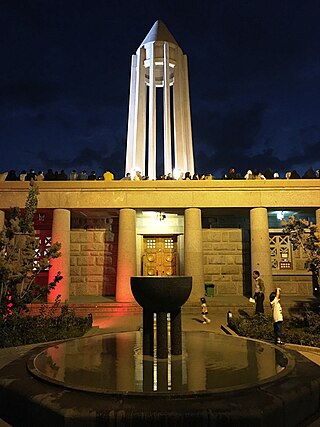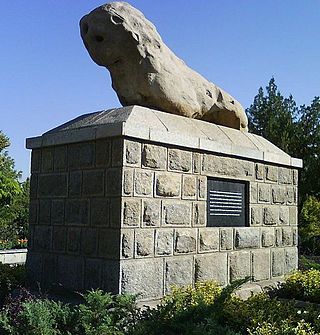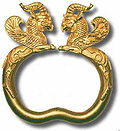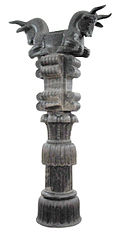
The Persian Gulf, sometimes called the Arabian Gulf, is a mediterranean sea in West Asia. The body of water is an extension of the Indian Ocean located between Iran and the Arabian Peninsula. It is connected to the Gulf of Oman in the east by the Strait of Hormuz. The Shatt al-Arab river delta forms the northwest shoreline.

Ecbatana was an ancient city and the capital of the Median kingdom, making it the first capital of Iran. It later became the summer capital of the Achaemenid and Parthian empires. It was also an important city during the Seleucid and Sasanian empires. It is believed that Ecbatana is located in the Zagros Mountains, the east of central Mesopotamia, on Hagmatana Hill. Ecbatana's strategic location and resources probably made it a popular site even before the 1st millennium BC. Along with Athens in Greece, Rome in Italy and Susa in Khuzestan, Ecbatana is one of the few ancient cities in the world that is still alive and important, representing the current-day Hamadan.

Hamadan Province is one of the 31 provinces of Iran. Its capital is the city of Hamadan. In the Zagros Mountains, the province covers an area of 19,546 km2.
Nahavand is a city in the Central District of Nahavand County, Hamadan province, Iran, serving as capital of both the county and the district. It is south of the city of Hamadan, west of Malayer and northwest of Borujerd.

The stone lion of Hamadan is a historical monument in Hamadan, Iran.

The Natural History Museum at Tring was the private museum of Lionel Walter, 2nd Baron Rothschild; today it is under the control of the Natural History Museum, London. It houses one of the finest collections of stuffed mammals, birds, reptiles and insects in the United Kingdom. It was known as the Walter Rothschild Zoological Museum until April 2007. The museum is located on Akeman Street, in Tring, Hertfordshire.

Deyr County is in Bushehr province, Iran. Its capital is the city of Bandar-e Deyr.
The wildlife of Iraq includes its flora and fauna and their natural habitats. Iraq has multiple biomes from mountainous region in the north to the wet marshlands along the Euphrates river. The western part of the country is mainly desert and some semi-arid regions. As of 2001, seven of Iraq's mammal species and 12 of its bird species were endangered. The endangered species include the northern bald ibis and Persian fallow deer. The Syrian wild ass is extinct, and the Saudi Arabian dorcas gazelle was declared extinct in 2008.
The 2007–08 Persian Gulf Cup was the 25th season of Iran's Football League and seventh season of Iran Pro League since its establishment in 2001. Saipa were the defending champions. The season featured 13 teams from the 2006–07 Persian Gulf Cup and three new teams promoted from the 2006–07 Azadegan League: Shirin Faraz as champions, Pegah and Sanat Naft. PAS Hamedan replaced PAS Tehran. The league started on 16 August 2007 and ended on 17 May 2008. Persepolis won the Pro League title for the first time in their history.

The University of Iowa Museum of Natural History is a natural history museum on the University of Iowa campus in Iowa City, Iowa. The museum was founded in 1858 by instruction of the Iowa General Assembly as the Cabinet of Natural History. It is housed within Macbride Hall, located in the Pentacrest area of the university campus. The museum's collections contain around 140,000 objects, including approximately 31,000 birds, eggs, and nests, 5,000 mammal specimens, 41,000 insects, 44,000 other invertebrates, 6,000 archaeological specimens, and historical documents and images from the museum's history. The museum includes several galleries on Iowa's geological and cultural history, biological diversity, and environmental science, spanning four floors. Major research collections include the Kallam Collection of prehistoric stone tools, the Talbot and Jones Bird Collections, the Frank Russell Collection of Inuit and Native Arctic artifacts, and the Philippine Collection of ethnographic materials from the 1904 World's Fair.

The Natural History Museum of Oman is a natural history museum, located at the Ministry of Heritage and Culture complex, Al Khuwair, opposite the Zawawi Mosque in Muscat, Oman.

Maryanaj is a city in the Central District of Hamadan County, Hamadan province, Iran.

A zoological specimen is an animal or part of an animal preserved for scientific use. Various uses are: to verify the identity of a (species), to allow study, increase public knowledge of zoology. Zoological specimens are extremely diverse. Examples are bird and mammal study skins, mounted specimens, skeletal material, casts, pinned insects, dried material, animals preserved in liquid preservatives, and microscope slides. Natural history museums are repositories of zoological specimens
Varkaneh is a village in Alvandkuh-e Sharqi Rural District, in the Central District of Hamadan County, Hamadan Province, Iran. At the 2006 census, its population was 848, in 196 families.
Abshineh is a village in, and the capital of, Sangestan Rural District of the Central District of Hamadan County, Hamadan province, Iran.
Hamadan is a city in Hamedan Province, Iran.

The Natural History Museum of Isfahan, Iran, is located in a building that dates from the 15th century Timurid era. The building includes large halls and a veranda which are decorated by muqarnas and stucco. This building became a museum in 1988.
The 2013–14 Iranian Futsal Hazfi Cup were the 1st season of the Iranian futsal knockout competition. Mahan Tandis Qom won the title with defeating Misagh Tehran in the final.

Hamadan is a city in western Iran. It is located in the Central District of Hamadan County in Hamadan province, serving as the capital of the province, county, and district. As of the 2016 Iranian census, it had a population of 554,406 people in 174,731 households.
The following is a timeline of the history of the city of Hamadan, Iran.
















